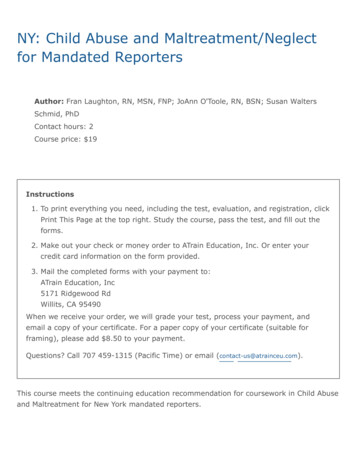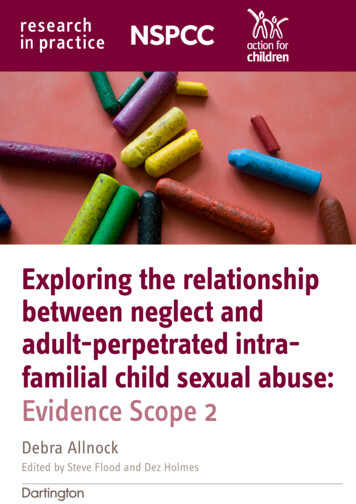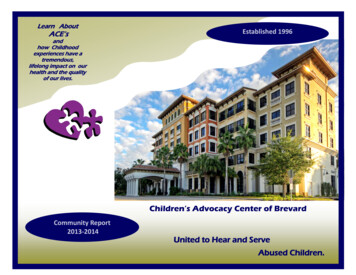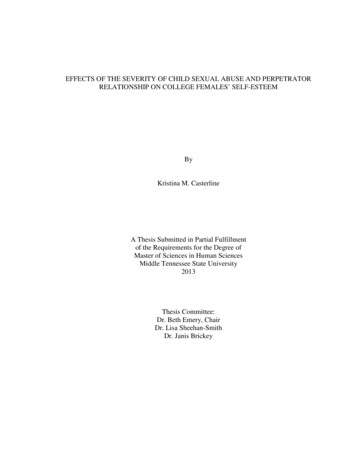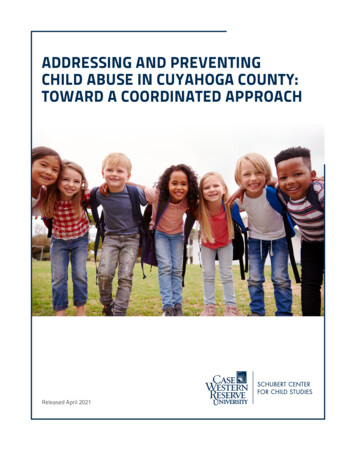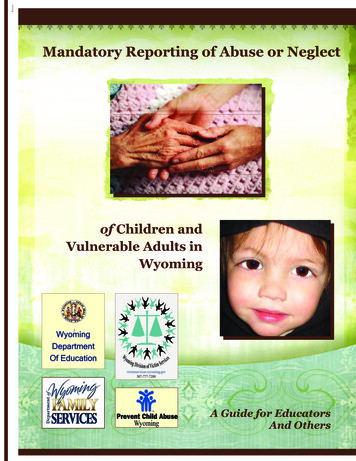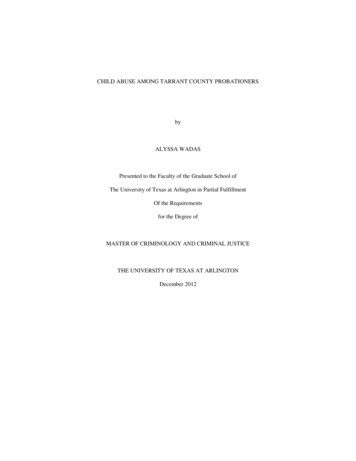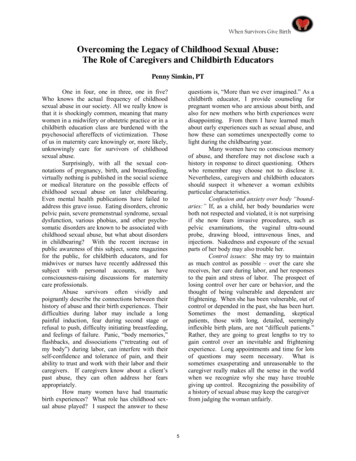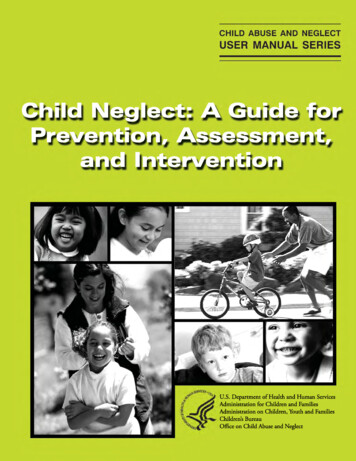
Transcription
UNLV Center for Democratic CultureEdited by Dmitri N. ShalinThe Social Health of NevadaLeading Indicators and Quality of Life in the Silver StateChild Abuse and Neglect in NevadaRamona W. Denby, Arizona State University School of Social Work;Hanna Haran, Arizona State UniversityIntroductionChild maltreatment in Nevada reflects thegeneral social, economic, and healthconditions within the state and its localcommunities. This chapter starts withvarious definitions of child abuse andneglect, focusing on the approach adoptedby Nevada legislators and comparing itwith competing definitions. Next, thisreport examines child abuse and neglectrates in Nevada and tracks the progress thestate has made toward achieving its goalsrelated to child welfare outcomes,including child protection and safety, childpermanency, and child well-being. Thediscussion then moves to the mostpromising child welfare interventionpractices and approaches. Finally, thechapter outlines the emerging trends andfuture directions in child welfare, focusingin particular on workforce es. At the end of this report,readers will find Appendix A, listing majorchild welfare data sources and Appendix B,identifying key child and ems in Nevada.Chapter Highlights In 2016, a little over 80% of child welfarecases in Nevada involved some level ofneglect. In 21% of Nevada cases, parental substanceabuse was cited as the primary reason forchild welfare intervention. 39% of abused children in Nevada are 3 yearsor younger, which is higher than the nationalaverage of 35% in the same age group. African American children compose about10% of the Nevada child population, yet theymake up 22% of the substantiated cases ofmaltreatment.How to Cite this ReportDenby, Ramona W., & Haran, Hanna, 2018.“Child Maltreatment in Nevada.” In TheSocial Health of Nevada: Leading Indicatorsand Quality of Life in the Silver State, editedby Dmitri N. Shalin. Las Vegas, NV: UNLVCenter for Democratic Culture,http://cdclv.unlv.edu
1Nevada’s ChildrenBetween 2010 and 2016, the population of Nevada children under the age 18 ranged fromabout 681,033 to 677,427. Reports of child maltreatment in this period varied, but thegeneral trends pointed toward the increase. As Table 1 shows, reports of maltreatmentwere at a high of 42.3 children per 1,000 in 2015 and at a low of 31.8 children per 1,000in 2010. For substantiated child maltreatment cases, Nevada’s rates rose from 6.8 per1,000 children in 2010 to 7.2 per 1,000 children in 2016.Table 1. Nevada: Child Population Data and Prevalence of Child Abuse and Neglect (2010–2016)Year2010201120122013201420152016Total Children 7Children subject ,27727,83331.8 per10004,6546.8 per100035.7 per10005,3558.1 per100033.9 per10005,4378.3 per100035.9 per10005,4388.3 per100037.8 per10004,5896.9 per100042.3 per10004,9537.4 per100041.1 per10004,8917.2 per1000Data Sources: U.S.DHHS (2013;2018).Table 2. (Substantiated Child Maltreatment Cases by County-Nevada)County201420152016Clark County2,5222,2582,286Washoe County681612555Rural Counties178149184Data Source: Department of Health and Human Services State of Nevada (2018).Clark and Washoe County are the two largest counties in Nevada. According to the U.S.Census, in 2010, Clark County had a population of over 1.9 million people and WashoeCounty had over 420,000 people. The two counties combined compose over 85% ofNevada’s population. As Table 2 shows, 95% of substantiated child maltreatment caseswere in Clark or Washoe County.
2Child Maltreatment: What It Is and Why It IsTerms and DefinitionsChild maltreatment can be defined from multiple perspectives reflecting differentassumptions and legal parameters that are framed by federal legislation and statestatutes. Crosson-Tower (2002) pinpoints three major schools of thought in this area: (1)penal-legal, (2) medical-scientific, and (3) social welfare-humanistic. The penal-legalframework equates maltreatment with cruelty. The medical-scientific approach viewsmaltreatment through the lens of the battered-baby syndrome. And the social welfarehumanistic perspective sees the phenomenon as child abuse.Federal PerspectiveAll three theoretical perspectives tell us something important about child maltreatment,but federal and state laws provide the definitive reference point. Government concernwith child maltreatment is grounded in the legal concept parens patriae, which assertsthat the government has to take the initiative in protecting children when their parentsfail or are unable to do so. Federal authority in this area is supported by nearly two dozenmajor child welfare laws enacted by the U.S. Congress (Curtis & Denby, 2011). Federallaw defines the minimal standards, violation of which constitutes child maltreatment.The 1974 Child Abuse Prevention and Treatment Act (CAPTA) P. L. 93-247 (amended bythe 2003 Keeping Children and Families Safe Act) defines child abuse and neglect as “anyrecent act or failure to act on the part of a parent or caretaker which results in death,serious physical or emotional harm, sexual abuse or exploitation; or an act or failure toact which presents an imminent risk of serious harm” (Child Welfare InformationGateway, 2008, p. 2).Guided by federal law, most states recognize four types of child maltreatment: (1)physical abuse, (2) neglect, (3) sexual abuse, and (4) emotional abuse. According to theChild Welfare Information Gateway (2008), physical abuse is a nonaccidental physicalinjury that can occur as a result of punching, beating, kicking, biting, shaking, throwing,stabbing, choking, hitting, or burning that is inflicted by a parent or caregiver. Neglect isfailure to provide for a child’s physical, medical, educational, and/or emotional needs. Inmost states, neglect also includes child abandonment and elements of substance abuse,including prenatal exposure to illegal drugs and other substances. Child neglect causedby substance abuse covers manufacturing drugs in the presence of a child; selling,distributing, or giving drugs and/or alcohol to a child; and the use of a substance by acaregiver that impairs the caregiver and limits his or her ability to care for the child.Federal law defines child sexual abuse as “the employment, use, persuasion, inducement,enticement, or coercion of any child to engage in, or assist any other person to engage in,any sexually explicit conduct or simulation of such conduct for the purpose of producinga visual depiction of such conduct; or the rape, and in cases of caretaker or inter-familialrelationships, statutory rape, molestation, prostitution, or other form of sexualexploitation of children, or incest with children” (Child Welfare Information Gateway,2008, p. 3). Emotional abuse (also referred to as psychological abuse) is a pattern ofbehavior on the part of a parent or caregiver that results in a child’s diminished sense ofself-worth. Emotional abuse is difficult to prove; it typically accompanies other forms ofabuse and is evident in criticism, threats, and rejection.
3Nevada State StatuteAccording to Nevada statute, child maltreatment is a condition or set of interrelatedconditions that involve physical abuse, sexual abuse, socio-emotional abuse, and/orvarious parameters of neglect. Child maltreatment is an act of omission or commissionon the part of a parent of caregiver that results in physical, cognitive, emotional, or socialharm to a child. Nevada’s definition of child abuse and neglect encompasses threecategories: (1) physical or mental injury of a nonaccidental nature, (2) sexual abuse orsexual exploitation, or (3) negligent treatment or maltreatment of a child caused orallowed by a person responsible for the welfare of the child under circumstancesindicating that the child’s health or welfare is harmed or threatened with harm (Chapter432B, 2011). Moreover, in Nevada, definitions of maltreatment are operationalizedthrough a risk assessment process that is framed by the Nevada Administrative Code(NAC) 432B.180 and differentiated by levels of urgency. According to the NAC,impending danger to a child results from a family situation or a household member’sbehavior that is determined to be out of control and will likely result in serious harm to achild (this was previously known as “foreseeable danger”). Present danger is animmediate, significant, and clearly observable family condition that is actively occurringor in process of occurring at the point of contact with a family and will likely result ingrievous harm to a child.Correlates of Child MaltreatmentGiven the serious nature of child abuse and neglect and its adverse consequences, manyhave asked, “What causes child abuse and neglect?” Although there have been no findingsthat indisputably draw a cause-and-effect relationship, several conditions are believed toinduce child maltreatment. Poverty, substance abuse, and parental mental healthdisorders are three of these conditions.Poverty and Economic ConditionsAs an environmental factor, poverty and low-income status are highly correlated withchild maltreatment, especially child neglect. It is important to note that poverty does notautomatically cause child neglect—the majority of families living in poverty are fullyfunctional and possess many strengths, including a host of protective factors that guardagainst child maltreatment. Yet poverty is implicated in child maltreatment insofar as itputs a family at a greater risk, especially when poverty is compounded by otherenvironmental risks such as parent’s age, substance abuse, and parental capacity andreadiness. It has been proven that the level of child well-being in any given state isassociated with the state’s child poverty rate (DePanfilis, 2006; Slack, Holl, McDaniel,Yoo, & Bolger, 2004). In Nevada, the poverty rate for children under the age of 18 is 22%,19.8% for children aged 5–17, and 27% for children under age 5 (Child Welfare League ofAmerica, 2016). These rates are commensurate with national child poverty rates. In2016, nationally, the poverty rate for children under the age of 18 was 20.7% (ChildWelfare League of America, 2018).Substance AbuseParental substance abuse is another condition highly correlated with child maltreatment(Goldman & Salus, 2003; Kelley, 2002). In fact, child neglect has the strongestassociation with substance abuse compared with all forms of child maltreatment
4(DePanfilis, 2006). One study found that 65% of maltreated children were victimizedwhile the parent was intoxicated (Donahue, 2004). Tragically, substance abuse isassociated with two thirds of child maltreatment fatalities (Kelley, 2002). Impairedparents are unable to function fully in the care and protection of their children, oftenplacing children in unsupervised conditions. Parents’ decision-making ability is impairedwhen they are under the influence; their judgment becomes compromised as their focusis narrowed by the addiction. Older children can be “parentified” or pressed to be parentsurrogates and serve as caregivers for their younger siblings. In Nevada, approximately2.26% of adults age 26 and older are reported to be dependent on or abusing illicit drugs(Substance Abuse and Mental Health Services Administration, Office of Applied Studies,2016). The Nevada law directs responsible authorities to notify a government agencyabout infants exposed to substances. Here is how Nevada Revised Statute § 432B.220 (3)defines the issue:Any person who is a mandated reporter who delivers or provides medicalservices to a newborn infant and who, in his or her professional oroccupational capacity, knows or has reasonable cause to believe that thenewborn infant has been affected by prenatal illegal substance abuse or haswithdrawal symptoms resulting from prenatal drug exposure shall, as soonas reasonably practicable but not later than 24 hours after the person knowsor has reasonable cause to believe that the newborn infant is so affected orhas such symptoms, notify an agency that provides child welfare services ofthe condition of the infant and refer each person who is responsible for thewelfare of the infant to an agency that provides child welfare services forappropriate counseling, training, or other services. A notification and referralto an agency that provides child welfare services shall not be construed torequire prosecution for any illegal action. (Child Welfare InformationGateway, 2009, p. 21)In Nevada the federal Child and Family Services Review (CFSR) revealed that in 61% ofall child welfare cases, substance abuse was cited as a reason that the child came to theattention of the child welfare system. In 27% of the cases, parental substance abuse wascited as the primary reason for child welfare intervention (Young, Gardner, Whitaker,Yeh, & Otero, 2005).Parental Mental HealthThe connection between parents’ mental health and child maltreatment is less definedthan the connection with poverty and substance abuse. However, certain mental healthconditions such as depression have been associated with child maltreatment anddiminished parenting abilities (Barth, 2009; Hoffman, Crnic & Baker, 2006; Jameson etal., 1997; Kahng et al., 2008; Shay & Knutson, 2008; U. S. Department of Health andHuman Services, 2003). Nevada ranks fifth in the nation of states considered to have thehighest number of depressed adults as determined by the number of depressive episodesand serious psychological distress (Mental Health America, 2011).
5Prevalence of Child Maltreatment in NevadaPrevalence and Types of Maltreatment and Demographic DataIn Nevada, as nationally, child neglect is the most frequently occurring type of childmaltreatment. In 2016 a little over 80% of child welfare cases involved some level ofneglect.Table 3. Types of Maltreatment–Nevada 775.673.673.780.3Physical Abuse32.837.034.736.434.733.526.2Sexual Abuse7.56.64.95.34.75.65.5Emotional Abuse1.71.61.71.00.80.80.5YearData Sources: U.S.DHHS (2013;2018). *Categories do not sum to 100% because of co-occurring conditions.Although child maltreatment in Nevada generally mirror regional and national patterns,there are some observable differences. For example, in 2016 about 26% of Nevada’ssubstantiated cases of child maltreatment had some element of physical abuse, comparedwith an 18% rate nationally.Table 4. Types of Maltreatment–National (%)YearNeglectPhysical AbuseSexual AbuseEmotional 8.55.60.0Data source: U.S. DHHS (2013; 2018).Table 5. Types of Maltreatment (%) – .380.5Neglect82.6Physical Abuse13.013.112.311.911.711.511.5Sexual motional Abuse81.182.6Data source: U.S. DHHS (2013; 2018).Table 6. Types of Maltreatment (%) –Arizona
6YearNeglect2010 201187.3 93.9Physical AbuseSexual AbuseEmotional 0.18.33.50.1Data source: U.S.DHHS (2013; 2018).From a regional standpoint there are also observable similarities and differences in thetypes and prevalence of child maltreatment. For example, Nevada is most similar toColorado with respect to patterns of child neglect. However, when Nevada is comparedwith its eastern neighbor (Utah) there are fewer similarities. For example, significantlymore of Nevada’s child welfare cases involve neglect, while Utah has more physical andemotional abuse cases.Table 7. Types of Maltreatment (%) – UtahYearNeglectPhysical AbuseSexual AbuseEmotional 129.1201525.741.121.229.2201628.745.417.429.7Data Source: U.S. DHHS (2013; 2018).From a national perspective, Nevada has been consistently below the U.S. average ofchild maltreatment cases. In 2016 7.2 out of 1,000 children in Nevada were victims ofchild maltreatment compared to 9.1 per 1,000 children nationally. Nevada had a lowerprevalence rate than California – 7.6 child victims per 1,000 children, Utah – 10.4 per1,000 children and Colorado-8.9 per 1,000 children. Nevada had a slightly higherprevalence rate than Arizona – 6.6 cases per 1,000 children.
7Data Source: U.S. Department of Health and Human Services, Child Maltreatment 2016, (2018)Table 8 Child Victims, 2012–2016StateAlabamaAlaskaArizona2012 Rate per 1,000Children2013 Rate per 1,000Children2014 Rate per 1,000Children2015 Rate per 1,000Children2016 Rate per 10.39.39.99.110.4Delaware11.49.47.37.57.7District of 5.9Nevada8.38.36.97.47.2New Hampshire3.33.02.42.83.5New Jersey4.44.75.84.94.2New Mexico11.512.915.217.515.3New York15.616.015.215.415.9North Carolina3.93.43.73.43.1North 21.21.21.31.6Puerto Rico10.111.010.09.5-Rhode Island14.814.616.115.114.2South Carolina10.69.711.513.615.8South 89.19.29.1-----West VirginiaReporting States
8Child maltreatment in the U.S. in the international perspectiveChild maltreatment is a pervasive issue affecting children throughout the world. Anestimated 1 out of 15 children experience maltreatment worldwide annually (Ferrara etal., 2015). The United States prevalence rate of child maltreatment is slightly higherwhen compared to other developed countries. The U.S. child maltreatment rates areclo0sest to that of the United Kingdom but noticeably higher than rates in Canada andItaly.Table 9. (Child Maltreatment Rate (%) by Country)Country2015United StatesCanada12.19.7United Kingdom11.2Italy9.5Data Source: Ferrara et al., 2015.Children of Color and Other Special PopulationsSome children in the child welfare system are considered to have “special needs.”Although there is no federal definition of “special needs” and the term’s meaning variesfrom state to state, within the context of child welfare adoption, special needs childrencan include “children of color; those who are older; children with siblings; or those witha medical, physical, or emotional condition or disability that results in the need foradoption or medical assistance in order for them to be adopted” (Child WelfareInformation Gateway, 2010a, p. 2). In the realm of general child welfare practice, specialneeds children are often classified in such a manner because of the vulnerabilities theyface, their disproportionate representation, and the difficulties they experience withrespect to achieving permanency.Two special needs groups in particular, African American children and young children,have received a fair level of empirical examination in the literature. There is substantialevidence indicating that African American children’s condition within the child welfaresystem is very precarious, and they are detrimentally affected by the system (Curtis &Denby, 2011; Hill, 2001, 2006; Roberts, 2002; U.S. GAO, 2007).They aredisproportionately represented at nearly every point in the child welfare system(including rates of entry into the foster care system); they have slow departure rates aswell as a host of other well-documented adverse conditions of care (Hill, 2006; Roberts,2002; U.S. GAO, 2007). In Nevada, African American children represent 22% of thesubstantiated cases of maltreatment yet they are only about 10% of the child population.
9Table 10. Ethnicity/Race of Maltreatment Victims (%) – 91.10.81.00.90.8Native Hawaiian /OtherPacific Islander1.20.51.20.70.90.90.7Alaska Native /AmericanIndian0.90.90.70.50.90.6Two or more races6.66.77.46.67.46.50.86.4Data Source: U.S. DHHS (2013; 2018).Racial disparity is also evident in child placement rates. As indicated in Tables 11 and 12,about 4,200 children were residing in foster care in Nevada in 2016, with AfricanAmericans accounting for over 20%. Many states have developed strategies foraddressing racial disproportionality in child welfare. (For a review of major initiatives atboth the state and federal level, visit the Child Welfare Information Gateway AddressingRacial Disproportionality in Child Welfare report, which is accessible through this link:http://www.childwelfare.gov/pubs/issue briefs/racial disproportionality/racial disproportionality.pdf. The Center for the Study of Social Policy Strategies to Reduce RaciallyDisparate Outcomes in Child Welfare report can be retrieved through this -Outcomes-in-Child-Welfare-March-2015.pdf).Table 11. Nevada Foster Care Data (2010–2016)Breakdown of Children in Foster CareYear2010201120122013201420152016# of children infoster care4,8114,6384,7454,7764,5434,4894,251Average lengthof stay (months)14.813.911.912.112.311.912.6Data Sources: U.S. DHHS (2017) & Nevada Child and Family Services (2016)
10Table 12. Ethnicity/Race of Children in Foster Care n0.70.81.11.00.90.80.7Native Hawaiian /OtherPacific Islander0.70.40.70.80.40.60.5Alaska Native /AmericanIndian0.70.80.91.01.20.9Two or more races7.78.17.78.29.613.10.97.7Data sources: U.S. DHHS (2017) & Nevada Child and Family Services (2016)Young children are an especially vulnerable group when it comes to child welfare. Thirtynine percent of the children who are maltreated in Nevada are 3 years old or younger.This figure is higher than the national average of 35% of maltreated children in thecomparable age group (U.S. Department of Health and Human Services, Children’sBureau, 2018).Table 13. Age of Maltreatment Victims (%)Year2010201120122013201420152016Children 116.916.416.816.716.816.417.2Children 1–3 years old23.623.623.222.221.922.622.1Children 4–7 years old23.923.723.926.025.224.524.5Children 8–11 years 918.218.3Children 12–18 years oldData sources: U.S. DHHS (2013; 2018).Consequences of MaltreatmentThe consequences of child maltreatment can be grave, and they often vary, depending onthe age of the child victim and the type of abuse or neglect that has been suffered.Children suffering abuse and neglect manifest the effect differently depending on the
11presence of protective factors and other safeguards buffering or mitigating the impact ofmaltreatment. Below is a brief summary of the effects of physical abuse, neglect, sexualabuse, and emotional abuse.Effects of Physical AbusePhysical abuse can affect a child’s physical well-being, emotional development, and socialmaturity. Older children who have been physically abused are susceptible to depressionand may show sadness and anxiety, while younger children can exhibit signs ofneurological impairments and/or sensory or psychomotor difficulties (Urquiza & Winn,1994). Physical abuse threatens healthy infant-child attachment (Aber, Allen, Carlson, &Cicchetti, 1990; Ainsworth, 1980).Effects of NeglectNeglected children may suffer from consequences of malnutrition, tend to be fragile, andare prone to disease. Among the less obvious consequences of child neglect are passivity,withdrawal, social isolation, depression, and impulsivity (Helfer, 1987). The normaldevelopment of neglected children is severely compromised; their motor, mental,language, and other developmental milestones lag behind those of normally developingchildren.Effects of Sexual AbuseChildren who have been sexually abused can experience immediate and lifelongconsequences. Victims may suffer physically from tears and abrasions in the genital area;they can contract sexually transmitted diseases or develop enuresis or encopresis. Otherconditions found among sexually abused include sleep disturbances, bedwetting, andsomatic complaints (Urquiza & Winn, 1994). The psychological effect of sexual abuse canbe seen in so-called “internalizing behaviors” (largely girls) or “externalizing behaviors”(largely boys), the symptoms of which include aggression, delinquency, hyperactivity, andverbal explosiveness. The effects that children suffer emotionally as a result of sexualabuse include distrust, hostility, low self-esteem, fear, and anxiety.Effects of Emotional AbuseEmotionally abused children share many of the symptoms characteristic of other formsof abuse, including physical reactions (e.g., sleep disturbance, somatic complaints) andemotional disturbances (e.g., self-destruction, depression, suicidal ideations) (CrossonTower, 2002). Psychological abuse is common in families where both children andadults are deprived of emotional fulfillment. This form of abuse breeds consequencesthat affect a child’s personality as he or she progresses into adolescence (O’Hagan,1993). Emotional abuse is not easy to decipher, and it tends to be less understoodcompared to other types of child maltreatment. And yet, its consequences can belifelong and profound.Achieving the Major Child Welfare OutcomesThe three major child welfare outcomes are (1) child safety, (2) permanency, and (3)family and child well-being. The 1994 amendments to the Social Security Act authorizedthe U.S. Department of Health and Human Services to review states to ensure that theyare in compliance with federal regulations as set forth in Titles IV-B and IV-E. The U.S.
12Children’s Bureau, through a process known as the Child and Family Services Reviews(CFSRs), administers a system that assesses children served by child welfare agencies andhelps states improve their children and family services (U. S. DHHS, Children’s Bureau,2011).The child welfare system in Nevada is organized into three jurisdictions. The first andlargest service jurisdiction is run by Clark County Department of Family Services(CCDFS). Located in Las Vegas, it provides child welfare services to all children andfamilies in Clark County and the southern part of the state. The second service areaencompasses Washoe County Department of Social Services (WCDSS). It is located inReno and provides coverage for children and families located in Washoe County and thenorthwestern part of the state. The third service jurisdiction (comprising rural regionaloffices) is run by the Division of Child and Family Services (DCFS) and provides childwelfare services to 15 counties. The Statewide Data Profile of Nevada provided by theAdministration for Children and Families on 6/8/2017 revealed that maltreatment whilein care is more frequent in Nevada compared with national rates, but there are someimprovements in the areas of permanency and well-being (for a complete review of theCFSR results see the 2018 Annual Progress Services Report available 18.pdf).Statewide data for FY 2017 reflected in the Continuous Quality Improvement (CQI) revealthat several safety outcomes are in need of improvement. The pattern repeats in the areasof permanency but there are some areas of strength, including placement with siblings.Also, although many of the child well-being areas are in need of improvement, Nevadaexceeds national standards with respect to visiting children in their residence (for acomplete review of Nevada’s April–December 2017 quarterly child and family servicesreview survey results here: U.S. Department of Health and Human Services, February2018 CFSR-Nevada Statewide Assessment).Child Welfare InterventionsChild welfare professionals use various interventions to assist children and families andpromote child safety, child permanency, and family and child well-being. Among themany approaches, family engagement models that are family-centered and strengthsbased are recognized as leading best practices. A growing body of evidence (assummarized by the Child Welfare Information Gateway, 2010b) suggests that the mosteffective family engagement strategies include, but are not limited to, the followingcomponents:1. Frequent and substantive caseworker visits. Frequent, meaningful, andfocused contact with families by caseworkers produces increased child safety,improved family functioning, and timely establishment of permanency.2. Family group decision-making (FGDM). FGDM has come to signify thegeneral use of a process in which families are empowered to engage moredirectly by joining forces with professionals and other vital support people inthe decision-making process. This approach is also known as family group
13conferences, family team conferences, family team meetings, and family unitymeetings.3. Motivational interviewing. Motivational interviewing is a counselingmethod designed to promote behavior change an
major child welfare laws enacted by the U.S. Congress (Curtis & Denby, 2011). Federal law defines the minimal standards, violation of which constitutes child maltreatment. The 1974 Child Abuse Prevention and Treatment Act (CAPTA) P. L. 93-247 (amended by the 2003 Keeping Children and Families Safe Act ) defines child abuse and neglect a s "any
